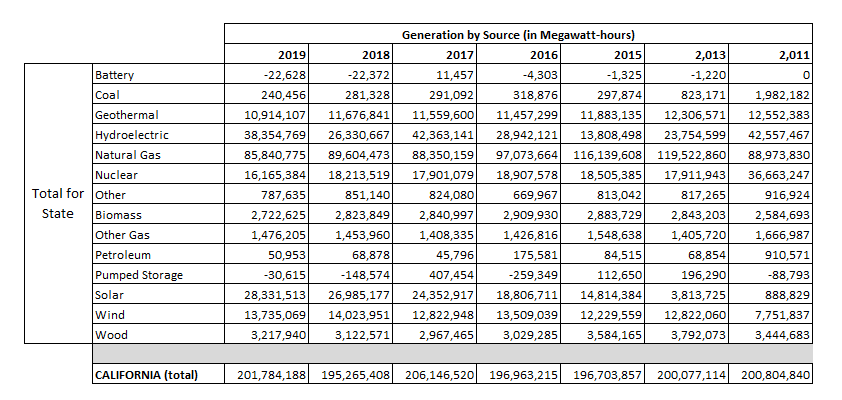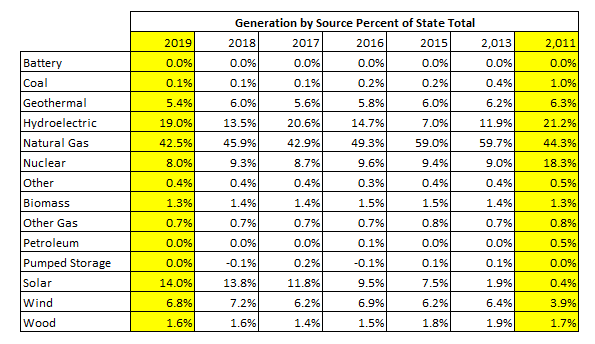California - The Land of Energy Make Believe, Now the Template for the Country
The housing bubble - which was sparked by President Clinton's goal of increasing home ownership to 67.5% - was an attempt by man to play God, and to suspend the laws of economics. The government's goal of greatly 'decarbonizing' the production of electricity in 10-15 years as part of a 'Green New Deal,' displays an even greater level of arrogance. The goal of decarbonizing electricity generation not only suspends the laws of economics, it also seeks to suspend the laws of engineering and physics.
In defense of all those pushing the Green New Deal, they cite the progress California has, (supposedly), made. While this progress looks good at first glance, a closer inspection reveals that California hardly provides a template for the rest of the country to follow. In fact, a review of California's so-called 'progress' on reducing the carbon footprint of its electricity generation shows just how fraught with enormous risk the Green New Deal is. The facts that make California a particularly poor model for other states to follow are;
- California gets a large fraction of its electricity from hydro (19%) and geothermal (5.4%) sources. (These figures are for 2019.) This energy production is an 'accident of geography,' and can't be duplicated where these natural features don't exist. (dams are hardly a wholly benevolent source of electricity either) (See Tables 1 and 3)
- California's per capita usage of electricity is one-half the national average. This has nothing to do with the environmental conscientiousness of Californians, or even the mild climate. Its the result of California being deindustrialized, and, the energy intensive products Californians use, being made elsewhere. (#1)
- After laboring on the task for close to two decades now, California still uses - on a percentage basis - more natural gas, (42.5%), than Texas, (38.4%), to make electricity. (See Table 3 and (#2) )
- California's progress on increasing renewable energy generation is rapidly decelerating. 2019's production of solar energy was just 5% higher than 2018. Production of wind energy has declined in several recent years, including 2019. (Table 2)
- The rapid deceleration in new renewable energy generation will be overwhelmed when the only remaining nuclear power plant in California, Diablo Canyon, shuts down. (Table 1) (#3)
- In 2019, Diablo Canyon produced over 16-million megawatt hours of electricity. In contrast, the production of solar electricity increased by just 1.3-million megawatt hours from 2018 to 2019. The production of wind electricity fell from 2018 to 2019. (Table 1)
- The operating licenses for Diablo Canyon's two reactors expire in 2024 and 2025. The growth in renewable energy production seen over the last few years in California will not be able to make up for this lost electricity production.
TABLE 1:

TABLE 2:

TABLE 3:

CONCLUDING REMARK:
Because of the hard work of engineers, skilled craftsmen and tradeworkers, along with an enormous physical capital infrastructure that has been built up over decades, electricity in the United States is provided reliably and at very low cost. As result, electricity is completely taken for granted, and few people appreciate the enormous amount of work that goes into producing it. This ignorance - along with an enormous amount of arrogance on the part of politicians - are what fuel the Green New Deal. As the review of California's so-called progress on increasing renewable energy generation shows, California hardly provides a model for the rest of the country to follow. California's per capita use of electricity is very low, and it greatly benefits from renewable sources, (hydro and geothermal), that aren't available elsewhere. Finally, its growth in renewable sources of power has started to level off. Moreover, if these growth rates don't dramatically increase over the next few years, wind and solar won't be able to bridge the gap created by Diablo Canyon shutting down. California, already the largest importer of electricity on both an absolute and relative basis, will be forced to import even more electricity from neighboring states. (4) Thus, California hardly provides an example for other states to follow.
Peter Schmidt
Sugar Land, TX
April 04, 2021 - Easter Sunday
PS - As always, if you like what you read, please register with the site. It just takes an e-mail address and I don't share this e-mail address with anyone. The more people who register with the site, the better case I can make to a publisher to press on with publishing my book. Registering with the site will give you access to the entire Confederacy of Dunces list as well as the financial crisis timeline.
Help spread the word to anyone you know who might be interested in the site or my Twitter account. I can be found on Twitter @The92ers
ENDNOTES:
1. "The Green New Deal will Make the Housing Bubble Seem Like Child's Play." California's per capita use of electricity is 0.72-kilowatt-hour per person, per hour. The national average is twice that, 1.45-kilowatt-hour per person per hour.
http://www.the92ers.com/blog/green-new-deal-will-make-housing-bubble-seem-childs-play
2. "Thank you sir, may I have another? ERCOT, Wind and Thermal Power." In 2019, Texas generated 38.4% of its electricity with natural gas. In 2019, California generated 42.5% of its electricity with natural gas.
http://www.the92ers.com/blog/thank-you-sir-may-i-have-another-ercot-wind-and-thermal-power
3. Diablo Canyon features two Westinghouse Pressurized Water Reactors. Unit 1 was placed into service in 1985 and Unit 2 in 1987. Since then, the site has been an extremely reliable source of huge amounts of power. There is a seismic fault in the area that I believe was discovered after construction of the site began. While the subsequent design would have been evaluated against this 'new' risk and upgraded as required, there may be valid reasons for shutting the facility down. The discussion here isn't arguing the merits of keeping Diablo Canyon open. Instead, the discussion here is limited to the observation that, the small increases in renewable energy production of the past few years, can't make up for the enormous loss in power from Diablo Canyon shutting down.
4. Data for California's electricity generation comes from the Energy Information Administration (EIA). See the link below and select 'Full Data Tables 1-16' for the raw data used in this report.
https://www.eia.gov/electricity/state/California/

